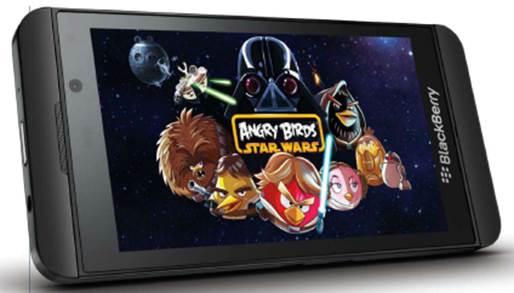The operating system
BlackBerry’s saving grace could be
BlackBerry 10. This first new OS from BlackBerry in years offers better video
support than Windows Phone 8, better messaging than Android, and more elegant
graphics than Apple’s iOS. It’s secure and manageable for businesses, and it’ll
be available on all four major U.S. carriers. And the “Hub”, the operating
system’s unified inbox for email, instant messaging, social networking, and
more, is terrific.
More important: BlackBerry 10 shows
innovation in its use of gestures that keep you always moving forward and let
you work up a real rhythm. The OS is not customizable like Android or Windows
Phone, but to some extent it customizes itself: Your eight most recently used
apps naturally form the backbone of what you do, and can update their pages as
new information comes in, potentially making them a little like Android’s
widgets or Windows Phone’s Live Tiles.

BlackBerry
Q10
In spite of these positive it’s a bit tough
to explain why consumers should veer over OSes that currently make up more than
90 percent of the U.S smartphone market. The Hub is excellent for messaging,
but Windows Phone and some Android devices have similar features; BBM is
powerful, but so are Apple Messaging, FaceTime, and Google Talk. BlackBerry
10’s new system of interaction makes it easy to flip between apps and the Hub,
but you can set up quick access to messaging on other operating system, too.
BlackBerry 10 also has the “version 1.0”
problem I encountered on Windows Phone 7: It’s entering a market with several
mature, powerful competitors. And although it does fine in isolation, it’s way
behind in terms of ecosystem. Every other platform has a lot more apps, and
Apple has ten times as many (though application developers can use the
BlackBerry 10 SDK to “wrap” their Android code in a BlackBerry-friendly form
that will help swell the ranks of available software). Google has a huge array
of devices at every price point. Microsoft has consumers, BlackBerry isn’t
providing a clear, simple reason why its ecosystem is better than the competition’s.

Powerful
hardware: The BlackBerry Z10 has sufficient power for playing demanding games,
but popular software may be tough to find at first.
All this isn’t to say there aren’t some
good reasons to choose 10 and the new phones that use it.t the most obvious
would be to have smartphones enterprise IT managers can control, but that
workers won’t reject as hideously out of date. Yet BlackBerry seems to be
working as hard as it can to avoid being pigeonholed into this market, which
seems counterproductive. There’s a scary, competitive welter of solutions out
there for managing smartphone deployments, and BlackBerry 10 looks like a calm,
clean, and compelling alternative. But because its app library so far lacks
some of the major brands iOS and Android have led users to expect, it will be
difficult for all but the most dedicated business-oriented smartphone owners to
make the jump.
BlackBerry’s future
The corporate factor definitely still plays
a role in BlackBerry’s potential success strategy. BlackBerry Balance and
BlackBerry Enterprise Server 10 make for a killer work-phone package. IT
managers who want to stick with BlackBerry but have been getting sneers from
iPhone and Android lovers will find much to like here.
But for the rest of us, the Z10 and
BlackBerry 10 OS don’t quite jump the threshold. Google and Apple both have
massive app and media libraries. BlackBerry promises software from EA,
Gameloft, Disney, BBC, ESPN, and more, but major releases like Instagram and
Netflix haven’t shown up on the prelaunch list.
BlackBerry’s heart is in messaging, with
its convenient Hub, excellent BBM voice and video chat, and Peek feature, which
lets you see your inbox from everywhere. What does that pair best with? A
killer hardware keyboard.
That means that the Q10, not that Z10, has
the best chance of rejuvenating BlackBerry’s fortunes with the new OS, which
may not be what BlackBerry wants. It also means the carriers have to cooperate.
Some have already embraced the Z10, but if most sit on the Q10 for months, the
operating system won’t gain the momentum it needs, and the Q10 itself will
never have a chance.
The Z10 and BlackBerry 10 aren’t bad, and
they’re certainly more in line with what today’s consumers expect from a
smartphone. But BlackBerry has yet to convince us that it’s poised to start
another revolution. Still, if BlackBerry can get its best releases out before
the next round of iPhones and Android and Android phones make them look like
yesterday’s news, BlackBerry could be the turnaround story we’ve all been
waiting for.

BlackBerry
10 and The Z10 aren’t bad, and they’re certainly more in line with what today’s
consumers expect from a smartphone.
5 ways for BlackBerry to succeed
1.
The company needs to explain why people should
buy these new products rather than safer and more dominant Android and Apple
devices.
2.
BlackBerry needs to have the top iOS apps that
are most talked about, and it needs to have them every month.
3.
It needs to have its phones in the stores,
immediately, on as many carriers as possible.
4.
The major U.S/ carriers need to be committed to
supporting BlackBerry
5.
Because of its business dependence, BlackBerry
needs to make clear that its phones are the ones you use to get things done.
|
BlackBerry
Q10 specs
·
Price: Not yet announced
·
Carriers: Not yet announced
·
Dimensions (HWD): 4.7 by 2.6 by 0.4 inches
·
Weight: 4.9 ounces
·
Screen Size: 3.1 inches
·
Screen Type: 720-by-720LCD
·
Screen Density: 330ppi
·
Processor: 1.5GHz dual-core Qualcoom
Snapdragon S4
·
Storage: 16BG internal, up to 64GB microSD
card
·
Camera: 8MP rear, 2MP front
·
Video Capture: 1080p rear, 720p front
·
Wi-Fi: 802.11a/b/g/n (2.4GHz, 5GHz)
·
Bluetooth: 4.0
·
NFC: Yes
·
4G LTE?: Yes
·
Battery: 1,800mAh
|